Waterproofing Concrete: ACCL Waterproofing
Waterproofing Concrete: ACCL Waterproofing
You can waterproof concrete from the positive (external) side, negative (internal) side, or from within the concrete itself to make it truly waterproof—that is, to prevent water passage while also resisting hydrostatic pressure (integral systems). Although sheet membrane waterproofing is the most extensively utilized positive-side method, breakdowns and restrictions are widespread and costly.
It’s challenging to keep up with advances in membranes and crystalline admixtures, and both technologies have seen significant developments. Here’s a quick rundown to help you make your decision.
Membrane Sheet Systems

A sheet membrane made of polymer components combined with asphalt and adhered to a polyethylene sheet is known as cold-applied polymer-modified bitumen. When compared to asphalt alone, the polymer is merged with the asphalt to generate a more viscous and less temperature-sensitive elastic material. These self-adhering sheets are free of the hazardous chemicals linked with asphalt adhesion. They also boost tensile strength, acid resistance, resilience, self-healing, and bonding ability.
Despite these developments, there are still drawbacks. Membranes require sealing, lapping, and finishing of seams at the corners, edges, and between sheets, which can be difficult to do. Sheet membranes must also be applied with a smooth finish that is free of cavities, honeycombs, and protrusions. Protection boards must be installed since the membrane can puncture and rip during backfilling.
Despite these disadvantages, sheet membranes have been the industry standard in waterproofing for many years and continue to dominate the market. Impact resistance, hardness, and overall longevity are reasons for their continued use when compared to other membrane solutions.
Membranes that are treated with liquid
Liquid-applied membranes are commonly made up of urethane or polymeric asphalt (hot or cold-applied) in a solvent base and can be applied with a brush, spray, roller, trowel, or squeegee. These membranes, which have high elastomeric qualities, are frequently put to the positive side of cured concrete. Negative-side applications are now possible because to recent technological advancements.
The thickness and uniform application of liquid-applied membranes are critical for successful waterproofing. They necessitate professional, experienced labour, a clean and dry substrate — which can be a challenge in the construction environment — a protection layer before backfilling, correctly cured concrete to avoid adhesion and blistering issues, and, for horizontal applications, a vapour barrier. When exposed to UV light, liquid-applied membranes degrade and cannot tolerate foot traffic. Toxic and dangerous volatile organic molecules are also present in the liquids (VOCs).
Liquid-applied membranes function well on projects with many plane transitions, elaborate geometric designs, and protrusions, but they are normally employed only when premade sheets fail.
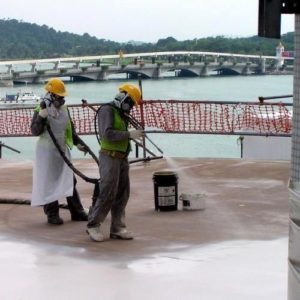
Admixtures
A new sort of waterproofing has been employed all around the world for the past three decades. These chemically reactive integrated additive systems are added to concrete at the batching plant or on-site. They turn the concrete itself become a water barrier, rather than establishing a barrier on the positive or negative side of the concrete. Densifiers, water repellents, and crystalline admixtures are all examples of integral concrete waterproofing systems.
Densifiers react with the calcium hydroxide generated during hydration to produce a by-product that enhances concrete density while slowing water migration. They aren’t often classified as waterproofing or repellant materials because they can’t seal cracks or joints. Additional waterproofing solutions are required to protect concrete from damage and deterioration when it is subjected to hydrostatic pressure.
The term “hydrophobic” refers to water repellents. Oils, hydrocarbons, stearates, and other long-chain fatty acid derivatives are common ingredients in these liquids. While hydrophobic systems are effective in damp-proofing, they are less effective at resisting liquid under hydrostatic pressure. Induced stresses produce cracking in concrete, which allows water to pass through. As a result, water repellents’ performance is mainly dependent on the concrete itself.
Admixtures with crystals
Crystalline-based systems are usually dry, powdery, and have a hydrophilic character. Unlike its hydrophobic competitors, crystalline systems utilise available water to create crystals inside concrete, successfully blocking moisture from damaging the material. They prevent water from entering from any direction because the concrete acts as a water barrier. When demolition happens, the crystalline formula has no VOCs and can be totally recycled.
In addition, crystalline admixtures have advantages in terms of installation. Unlike traditional membrane waterproofing, which is labor-intensive and costly, crystalline admixtures can be delivered in dissolvable, pulpable bags that are tossed into the concrete batch during mixing. By integrating stages with concrete placement, the building schedule is shortened and labor expenses are reduced.
In applications where there is a lot of movement, integral crystalline waterproofing systems should be avoided. Crystals align in a three-dimensional array during the crystallization process, which fractures when subjected to extreme movement. Areas that require flexibility and are subject to repeated movement, such as plaza decks or rooftops, should be waterproofed in a different manner.
Choosing the best product
In the construction industry, efficiency is crucial, and choosing the correct concrete waterproofing product for the task may make or break a project’s deadline. Concrete waterproofing manufacturers are collaborating with contractors more closely than ever before to understand their project’s specific requirements and guarantee they have the proper technology to safeguard their structures.
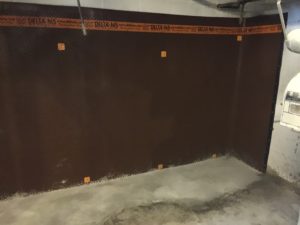
Take advantage of the warmer summer months to have us look at your basement and help you determine how best to address your basement leakage problems.

Get the job done RIGHT – Hire a professional Waterproofing company!
Want to know more about our waterproofing process? Give us a call at 416-759-2995
Rely On our ACCL Wet Basement Waterproofing Experts
Don’t Drown in a wet basement!
Rely On Wet Basement Waterproofing Experts
If you’ve noticed foundation cracks, spots, water, mold, and mildew, don’t ignore the signs or it could lead to more damage and possible health effects.
The basement waterproofing specialists at ACCL Waterproofing know how to repair your basement and foundation walls and keep moisture out of your basement. We would be pleased to develop a guaranteed solution to keep your basement dry!
Keeping Downspouts and Gutters Clean – ACCL Waterproofing
Keeping Downspouts and Gutters Clean – ACCL Waterproofing
One of the many reasons to clean your gutters and downspouts is to avoid basement water damage. Water can build in basements due to clogged gutters and downspouts, which you may not be aware of.
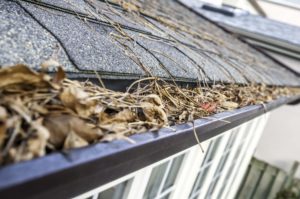
PERSERVE THE SAFETY AND DRYNESS OF YOUR BASEMENT
Most people who are aware of this want to keep their basements dry by having their gutters and downspouts cleaned on a regular basis. There are several companies that do this form of cleaning, and these services are usually inexpensive. Cleaning your gutters a few times a year is an excellent method to protect your home’s investment.
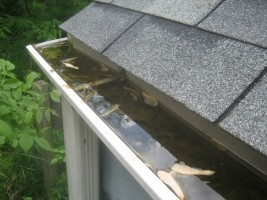
MORE ENDURING
Clean gutters and downspouts will last longer, in addition to preventing water from collecting in basements. The weight of their contents may pull the gutters away from where they are fastened if they are not cleaned. This could result in product damage or poor performance.
RISK OF COLDER WEATHER
If you live in colder climates, you are well aware of how bitterly cold winters can be. When your gutters aren’t cleaned, they might cause ice dams. This means that water flows over the sides of overflowing gutters and freezes. Water will eventually enter a home as a result of this.

VERMIN
Finally, rodents prefer to nest in blocked gutters, and you don’t need any more vermin in your property. Ants, mice, rats, and flying insects are among the critters that prefer clogged gutters.
Take advantage of the warmer summer months to have us look at your basement and help you determine how best to address your basement leakage problems.

Get the job done RIGHT – Hire a professional Waterproofing company!
Want to know more about our waterproofing process? Give us a call at 416-759-2995
Rely On our ACCL Wet Basement Waterproofing Experts
Don’t Drown in a wet basement!
Rely On Wet Basement Waterproofing Experts
If you’ve noticed foundation cracks, spots, water, mold, and mildew, don’t ignore the signs or it could lead to more damage and possible health effects.
The basement waterproofing specialists at ACCL Waterproofing know how to repair your basement and foundation walls and keep moisture out of your basement. We would be pleased to develop a guaranteed solution to keep your basement dry!
ACCL Waterproofing: Installing Drainage Systems!
How to Waterproof a Basement and Install a Basement Drainage System – The ACCL Way!
Is your basement constantly wet? Do April showers bring May flowers and a flooded basement? Then waterproofing your basement and installing a drain system with a sump pump may be necessary. A wet basement not only prohibits you from using extra space in your home, but it can also turn your basement into a large petri dish ideal for the growth of harmful molds and fungi.
10 STEPS!
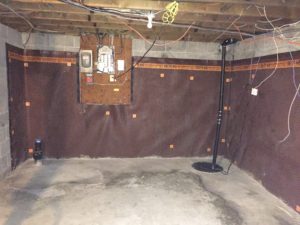
ACCL Waterproofing Step One:
It’s impossible to avoid the fact that breaking up concrete is a filthy task. While you’re working, switch off your furnace or central air conditioning and block all return air vents until you’re finished. Move everything out of the area and drape plastic from the ceiling to create an isolated workstation instead of covering it with plastic.
If you have an unfinished ceiling, make sure the plastic reaches all of the joist spaces. While using the jackhammer, place a fan in the window to help with the heavy dust. Also, put on a dust mask and earplugs. More measures to secure your house during remodeling efforts can be found here.
ACCL Waterproofing Step Two:
Electric jackhammers are preferred by professionals since pneumatic jackhammers generate significantly more dust. To begin, hammer a line 16 to 18 inches away from the wall. Begin by chipping in a straight line along the length of the wall, then return to break it down into manageable chunks. Return once the perimeter has been completed to break the concrete row into manageable fragments. If each component has enough freedom to pull away, it will break free more easily, so remove the sections as you go. Remember to make a larger area for your sump basin!
ACCL Waterproofing Step Three:
Dig down to the bottom of the footing but not below it once the concrete has been removed. You could wind up with cracks in your wall or worse if you jeopardize the soil beneath the footing. Use rubber feed buckets (usually used for farm animals) since they fit through narrow basement windows and are less likely to damage trim.
ACCL Waterproofing Step Four:
It’s ideal to put your basin in an unfinished basement area so you can get to the sump pump quickly. If you don’t intend to complete the basement, put the basin where you want the water to drain out of the house so you don’t have to install as much plastic tubing.
Dig the hole until the point where the top of the basin is flush with the finished concrete. Drill 1-inch holes in each block core and each mortar joint if your waterproofing basement walls are composed of concrete block. The water that collects in the cores and between the blocks will now be able to flow into the drain. Drill the holes as close as possible to the footings. It’s possible that the lower bricks are concrete-filled. You’ll have to demolish any existing walls and install foundation wrap in that instance. As you drill, place a shop vacuum hose close to the hole to reduce dust.
ACCL Waterproofing Step Five:
Place the basin in its final position before marking the locations of the holes where the pipes will meet the basin. Keep in mind that towards the basin, there will be a thin layer of rock (one layer thick) under the pipe. Use a reciprocating saw, jigsaw, or hole saw to make the holes. It is not necessary for the holes to be flawless. Don’t remove all of the dirt at once; some will be needed to fill in around the basin. Fill in around it once it’s permanently in place, tamping the ground with a 2×4 as you go.
ACCL Waterproofing Step Six:
Shovel in a bottom layer of 1-1/2-in. to 2-in. cleaned river rock before laying the pipe in the trench (a layer of smaller rock can become clogged with minerals and sediments). Every 10 feet, the pipe should slope at least 1/4 inch toward the basin. To get this pitch, rake the rock around. On top of the boulder, place your irrigation pipe. Because regular flexible drainpipe clogs easily, don’t use it. Schedule 10 perforated pipe with a 4-inch diameter is preferred.
Purchase a pipe with 1/2-inch rows. Only one side of the pipe has perforation holes, not all the way around. Install the pipe with the openings pointing down so that the minerals and sediment in the water can flow down and settle into the earth. The water that does rise up into the pipes from below will be reasonably clean as a result. Clean water will extend the life of the entire system by several years. Begin at the basin and push the male end of the pipe about 4 inches into the basin. At the corners, use PVC or ABS elbows. Cementing the parts together isn’t required.
ACCL Waterproofing Step Seven:
Drill a 1-inch hole in the core of each block and each mortar junction. After you’ve installed your pipe, you’ll need to connect it to the 1-inch irrigation hose that will bring the water from the blocks to the trench. Stick with irrigation hose because a softer hose, such as a garden hose, can be crushed flat by the new concrete. With a hacksaw or reciprocating saw, cut the hose. Make sure each hose portion is several inches past the footing.
ACCL Waterproofing Step Eight:
If your walls are made of poured concrete rather than block, you’ll need to build a foundation wrap to allow water to drain properly. The foundation wrap is constructed of durable plastic and has rows of dimples that allow water to pass through. With a utility knife, cut the sheets into strips. Allow the bottom half of the strips to run past the footing by bending them at 90 degrees. The length of the wrap against the wall is determined by your circumstances. Run the wrap up 4 in. above the top of the concrete on a poured wall, or up 4 in. past the holes you drilled in the block wall, at the very least. Try to tuck the wrap below the bottom plate if you’re working along stud walls.
ACCL Waterproofing Step Nine:
It’s time to cover it up after the hoses or foundation wrap are in place. Fill the trench with river rock up to the existing slab’s bottom, then cover the rock with a vapour barrier of at least a 6-mil thickness of plastic. Mix your concrete outside to reduce dust. For slabs and sidewalks, a bagged concrete mix will suffice. To “screed” the fresh concrete flush with the floor, slide a 3-foot strip of 2×4 along the floor and smooth it out with a hand float. After 20 minutes, use a finishing trowel to level it out. Fill the gap beneath any existing walls entirely with the float.
ACCL Waterproofing Step Ten:
Submersible pumps with a vertical float switch are more reliable than pedestal or float switch pumps, according to professionals. On the pump, install a 6- to 8-in. segment of pipe, followed by a check valve. Ensure that the check valve does not obstruct the pump switch. Attach another segment of pipe above the check valve, long enough to reach above the top of the basin. In the portion of pipe just below the check valve, drill a 1/4-in. to 3/8-in. vapour lock release hole.
This permits the pump to come up to speed before attempting to force open the check valve, which may be under pressure from many gallons of water. While the pump is running, angle the hole so that water pours down. It’s preferable if your pump has its own output. Other appliances connected to the same circuit may trip a breaker if extension cords go unplugged. The pipe exiting the basement must be placed in a sloped area away from the house.
Consider burying the waste pipe in the trench and having it come back up where you want it if it involves running a pipe back across the basement. If you reside in a cold environment and your pipe will discharge above ground, run it no more than 8 inches past the siding. In the winter, this will keep it from freezing. Basement drain water, with a few exceptions, cannot be put into city sewer systems.
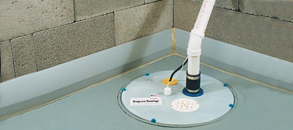
Most systems can be emptied into storm sewers if they are above ground level. Inquire with your building official about the rules in your region.
Take advantage of the warmer summer months to have us look at your basement and help you determine how best to address your basement leakage problems.

Get the job done RIGHT – Hire a professional Waterproofing company!
Want to know more about our waterproofing process? Give us a call at 416-759-2995
Rely On our ACCL Wet Basement Waterproofing Experts
Don’t Drown in a wet basement!
Rely On Wet Basement Waterproofing Experts
If you’ve noticed foundation cracks, spots, water, mold, and mildew, don’t ignore the signs or it could lead to more damage and possible health effects.
The basement waterproofing specialists at ACCL Waterproofing know how to repair your basement and foundation walls and keep moisture out of your basement. We would be pleased to develop a guaranteed solution to keep your basement dry!
How to Waterproof Concrete? – ACCL Waterproofing
HOW TO WATERPROOF CONCRETE?
A foundation issue is probably the worst thing that can happen to a residential building, apart from it burning down. The foundation is basically the foundation of the house; it is what holds the structure in place by moving dead and live loads into the earth.
The vast majority of foundation issues are caused by water. Wet soil beneath a foundation will expand and weaken.
That’s not even the most important reason to keep your foundation dry. There’s also the issue of cold, wet basements and crawl spaces, which can cultivate mold and make below-ground interior spaces uncomfortable in general. The issue is that ordinary concrete is not watertight.
Although uncracked concrete can usually keep liquid water out, water vapor will easily pass through. A good structure needs water to be drained away from concrete foundations and prevented from flowing through the concrete.

Depending on the geographic area, terrain, topography, soil/water table conditions, and foundation depth, achieving our task of draining some water and maintaining a dry interior space below grade can be relatively easy or reasonably involved. Any system built to keep water out has three components. From the bottom up, these are:
- Drains that direct water away from the foundation’s foundation.
- Water is routed down to the drains through a wall treatment that prevents moisture from passing through the wall.
- Treatment of the ground surface adjacent to the building to direct surface water away
Know that since this will be all underground when the construction is finished, doing it right the first time is important, as going back to repair it will be costly. A leaking foundation in a home can ruin the finishes and furnishings, as well as the structure itself. Water in a commercial building can destroy expensive machinery and cause major disruptions in operations. All of this adds up to money being lost, time is wasted, consumers are angry, and litigation is often necessary.
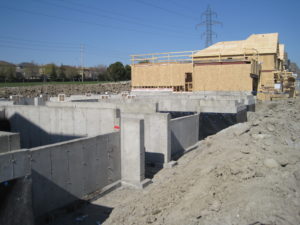
HOW TO MAKE A FOUNDATION WATERPROOF
Concrete Waterproofing Planning
Allow plenty of time to float for waterproofing. Recognize that good waterproofers will be in high demand during the busy season if you’re using a waterproofing subcontractor. Waterproofing work can also be delayed by rain.
Waterproofing should be planned ahead of time. The finish grade line on the foundation walls would most likely be seen on the design elevations, but these lines should be checked with the architect if possible. Above grade, you don’t want black, gooey waterproofing to show. Keep an eye out for changes in grade level. If the architect has chosen to tackle the transition with a retaining wall, a line of waterproofing descending at a diagonal from one level to another will not fit.
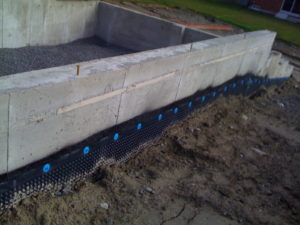
Take advantage of the warmer summer months to have us look at your basement and help you determine how best to address your basement leakage problems.

Get the job done RIGHT – Hire a professional Waterproofing company!
Want to know more about our waterproofing process? Give us a call at 416-759-2995
Rely On our ACCL Wet Basement Waterproofing Experts
Don’t Drown in a wet basement!
Rely On Wet Basement Waterproofing Experts in Toronto
If you’ve noticed foundation cracks, spots, water, mold, and mildew, don’t ignore the signs or it could lead to more damage and possible health effects.
The basement waterproofing specialists at ACCL Waterproofing know how to repair your basement and foundation walls and keep moisture out of your basement. We would be pleased to develop a guaranteed solution to keep your basement dry!
Why Summer is the Best Time to Waterproof: ACCL Waterproofing
ACCL WATERPROOFING: SUMMER TIME
The warmer weather in the summer is the most ideal time for homeowners to waterproof due to a number of reasons. Just because the weather is nice and the sun is out doesn’t mean it is safe from heavy rainfall, which are common during warmer temperatures, and could cause foundations to develop cracks. The more the rain continues the larger those cracks become as water erodes around the foundation. This would than cause water to be able to leak inside of the basement which is every homeowner’s nightmare.
Summer is better for waterproofing because the temperature and ground aren’t below freezing temperatures causing it to freeze and become difficult to excavate down to the footing. If the ground is hardened by the cold digging could sometimes not be able to be done properly making it more difficult to waterproof the property. With summer all that could happen is possible rainfall while working, which is perfectly manageable.
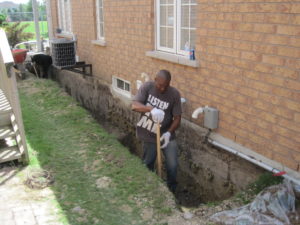
With hotter seasons it will allow for the waterproofing to dry and cure faster compared to colder ones, making the work more efficient and not as time-consuming. If there is any indication of leakage or cracks within the foundation it is recommended to get it done as soon as possible, especially during the summer.
LICENSED AND INSURED WATERPROOFING PROFESSIONALS
ACCL Waterproofing is a leader in basement waterproofing. We are experts in the waterproofing field and have been in business for over thirty years. We deal with everything related to waterproofing and offer warranties on each individual job.
WHAT WE OFFER –
Here are some of the features of our work that provide a strong case for waterproofing your basement during the summer months:
-
We offer competitive rates and deal with cracked foundations, crack injections, concrete work, sump-pumps, weeping tiles, and more. Our process is backed by our company’s high ratings and offered warranties no matter the scope of work.
-
In addition to waterproofing, we also offer underpinning.
-
Our repairs can be made to cracks found in both the interior and exterior sides of your basement walls.

Take advantage of the warmer summer months to have us look at your basement and help you determine how best to address your basement leakage problems.

Get the job done RIGHT – Hire a professional Waterproofing company!
Want to know more about our waterproofing process? Give us a call at 416-759-2995
Rely On our ACCL Wet Basement Waterproofing Experts
Don’t Drown in a wet basement!
Rely On Wet Basement Waterproofing Experts
If you’ve noticed foundation cracks, spots, water, mold, and mildew, don’t ignore the signs or it could lead to more damage and possible health effects.
The basement waterproofing specialists at ACCL Waterproofing know how to repair your basement and foundation walls and keep moisture out of your basement. We would be pleased to develop a guaranteed solution to keep your basement dry!
What is Efflorescence??
What Is Efflorescence buildup on Stone, Stucco, and Concrete?
Efflorescence is a salt mineral or crystal, it’s appearance looks white, grey and fuzzy. Found on the outside and inside of your basement walls, stone, stucco, concrete, or other building surfaces. It is a common problem in masonry block and concrete foundations. In this article the waterproofers at ACCL Waterproofing will go over what efflorescence buildup is and what you can do to prevent it.
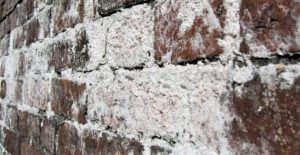
Is Efflorescence Buildup Harmful or cause damages?
The buildup isn’t hazardous, although seeing it could mean you have a moisture problem. Ignoring the signs can cause deterioration.
Correcting and fixing the moisture problem and leaks is efficient to efflorescence removal.
How Does Efflorescence Occur?
Water, rain and snow are the primary sources of moisture and may impact the degree of efflorescence
Three conditions exist before efflorescence can occur:
- There must be water-soluble salts present somewhere in the wall.
- In order for the salts to turn into a soluble solution there must be enough moisture in the wall.
- Soluble salts must have an open path in order to migrate/move through a material the surface. This will cause the moisture to evaporate and crystallize, resulting in efflorescence.
Efflorescence buildup cannot occur if any of these three conditions are not present.
More than often homes that are being built or under construction can make the masonry units become exposed to water and moisture (if they aren’t covered up properly) due to rain and other weather elements.
in many instances, efflorescence may occur during home construction. If masonry units are left out overnight during construction, they can absorb moisture from damp soil and rain. It is essential for masonry units to be covered and left in pallets to minimize the risk of efflorescence throughout a construction project.
Various building surface installation problems may lead to efflorescence, including:
Various building surface installation problems may lead to efflorescence, including:
- Incorrect use of through-wall flashing
- Use of masonry without sufficient ventilation
- Use of masonry in areas that lack a proper moisture barrier
- Joint material failure
- Improper ground storage
Effective Removal;
If you don’t regulate moisture problems, or if you have a leak in your house efflorescence will continue to re-appear.
How To Prevent Efflorescence?
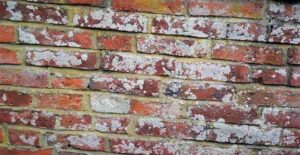
Seeing efflorescence crystals most likely means there is a leak somewhere letting outside water in. The best way to prevent this problem is to prevent the water from gaining access to the wall.
When the source of the water leak is found and stopped the walls should be cleaned with a remover or cleaner.
With the correct materials and construction it’s an easy fix! as it is a controllable condition.
The basement waterproofing specialists at acclwaterproofing.com know how to repair your basement and foundation walls and keep moisture out of your basement. Accl Waterproofing would be pleased to develop a guaranteed unique solution to keep your basement dry.
When you choose ACCL Waterproofing, you have the peace of mind, knowing that you have a trusted name in basement repair and waterproofing working to keep your basement dry.
Rely On our ACCL Wet Basement Waterproofing Experts
If you notice efflorescence around your homes interior or exterior walls, or if your home has increased moisture CALL 905-448-5904 or CLICK HERE to visit our contact page.
The basement waterproofing specialists at ACCL Waterproofing know how to repair your basement and foundation walls and keep moisture out of your basement. We would be pleased to develop a guaranteed solution to keep your basement dry!
[action full_width=’yes’ content_in_grid=’yes’ type=’simple’ icon=” icon_size=’fa-lg’ icon_color=” custom_icon=” background_color=” border_color=” show_button=’yes’ button_text=’Contact us today for all your waterproofing needs!’ button_link=’http://acclwaterproofing.ca/contact-us/’ button_target=” button_text_color=” button_hover_text_color=” button_background_color=” button_hover_background_color=” button_border_color=” button_hover_border_color=”] [/action]
